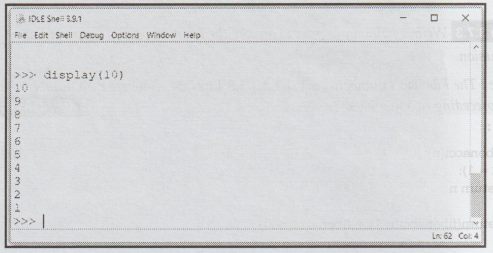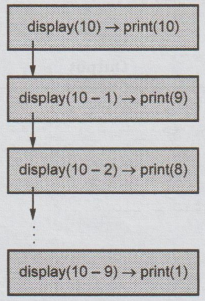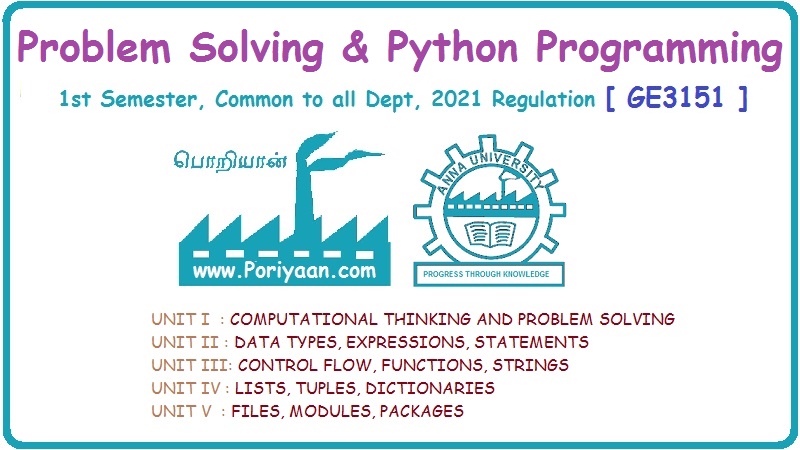Problem Solving and Python Programming: UNIT III: Control Flow, Functions, Strings
Recursion
Definition, Properties, Example Program, Advantages, Disadvantages, Comparison | Python Programming
Definition : Recursion is a property in which one function calls itself repeatedly in which the values of function parameter get changed on each call.
Recursion AU : Jan.-18, Dec.-19, Marks 10
Definition
:
Recursion is a property in which one function calls itself repeatedly in which
the values of function parameter get changed on each call.
Properties
of Recursion
There
are three important laws of recursion –
1.
A recursive function must have a base case.
2.
A recursive function must change its state and move toward the base case.
3.
A recursive function must call itself, recursively.
Example
3.7.1 Display the numbers from 10 to 1 (ie, numbers in
reverse order) using recursion in python. Also draw the stack diagram
representing the execution of the program.
Solution
:
def
display(n):
if
n < = 0:
return
else:
print(n)
display(n-1)
Output

The
execution of above program can be diagrammatically shown as follows:

Example
3.7.2 Write a python program for recursive factorial
function,
Solution
:
def
factorial(n):
if
n = = 0:
return
1
else:
result
= n * factorial(n-1)
return
result
print(factorial(5))
Output
120
Example
3.7.3 Write a python program to display the Fibonacci
series upto n numbers using recursion
Note
The Fibonacci numbers are 0,1,1,2,3,5,8,13,21,34,.., where each number is a sum
of the preceding two numbers.
AU
: Jan.-18, Marks 8
Solution
:
def
fibonacci(n):
if(n
< = 1);
return
n
else:
return(fibonacci(n-1)
+ fibonacci(n-2))
print("Enter
number of terms ")
n
= int(input())
print("Fibonacci
sequence is as follows...")
for
i in range(n):
print
(fibonacci(i))
Output

Example
3.7.4 Implement a recursive function in python for
sieve of Eratosthenes. The Sieve of Eratosthenes is a simple algorithm for
finding all prime numbers up to a specified integer.
AU
: Dec.-19, Marks 10
Solution
:
def
Sieve(i,num):
if
num = ri:
return
0
else:
if(num%i==0);
return
1
else:
return
Sieve(i+1, num)
n
= int(input("Enter last Number:"))
print("Prime
Number Between 1 to n are: ")
for
i in range(2,n+1):
if(Sieve(2,1)=
=0):
print(i,end="")
Output
Enter
last Number:50
Prime
Number Between 1 to n are:
2
3 5 7 11 13 17 19 23 29 31 37 41 43 47
>>>
1. Advantages and Disadvantages
Advantages
1)
It reduces the length of code.
2)
It is very useful while applying the same pattern of solution.
3)
It reduces unnecessary calling of function.
4)
Big and complex iterative solutions are easy and simple with Python recursion.
Disadvantages
1)
Recursive functions are slower than iterative solutions.
2)
It is hard to analyse or understand the code.
3)
It may require a lot of memory space to hold intermediate results on the system
stack.
4)
The computer memory may run out of memory if the recursive calls are not
properly checked.
2. Comparison of Recursions with Iteration
Recursion
1.
The function is called itself repeatedly.
2.
The intemal stack is used to store the set of local variables
3.
Recursion is always applied to function
4.
Slow in execution.
5.
Recursion reduces the size of the code.
Iteration
1.
The set of instructions is executed repeatedly
2.
It does not use stack.
3.
Iteration is applied to control statements such as for loops, while and do
while statements.
4.
Fast in execution.
5.
Iteration makes the code lengthy
Review Questions
1. Define recursion with an example.
AU: Dec.-19, Marks 2
2. What is recursive function ? What are its advantages and
disadvantages ? Compare it with iterative function.
AU: Dec 19, Marks 6
Problem Solving and Python Programming: UNIT III: Control Flow, Functions, Strings : Tag: Engineering Python : Definition, Properties, Example Program, Advantages, Disadvantages, Comparison | Python Programming - Recursion
Related Topics
Related Subjects
Problem Solving and Python Programming
GE3151 1st Semester | 2021 Regulation | 1st Semester Common to all Dept 2021 Regulation
